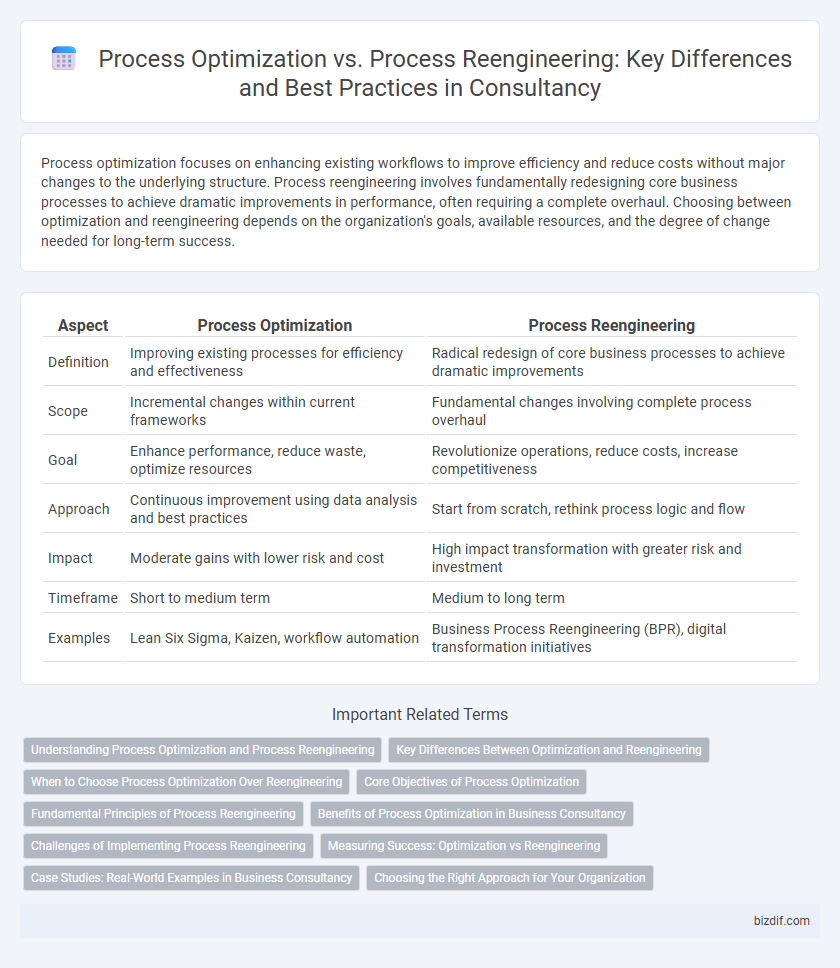Process optimization focuses on enhancing existing workflows to improve efficiency and reduce costs without major changes to the underlying structure. Process reengineering involves fundamentally redesigning core business processes to achieve dramatic improvements in performance, often requiring a complete overhaul. Choosing between optimization and reengineering depends on the organization's goals, available resources, and the degree of change needed for long-term success.
Table of Comparison
| Aspect | Process Optimization | Process Reengineering |
|---|---|---|
| Definition | Improving existing processes for efficiency and effectiveness | Radical redesign of core business processes to achieve dramatic improvements |
| Scope | Incremental changes within current frameworks | Fundamental changes involving complete process overhaul |
| Goal | Enhance performance, reduce waste, optimize resources | Revolutionize operations, reduce costs, increase competitiveness |
| Approach | Continuous improvement using data analysis and best practices | Start from scratch, rethink process logic and flow |
| Impact | Moderate gains with lower risk and cost | High impact transformation with greater risk and investment |
| Timeframe | Short to medium term | Medium to long term |
| Examples | Lean Six Sigma, Kaizen, workflow automation | Business Process Reengineering (BPR), digital transformation initiatives |
Understanding Process Optimization and Process Reengineering
Process Optimization focuses on incrementally improving existing workflows to enhance efficiency, reduce costs, and increase output without major structural changes. Process Reengineering involves fundamentally redesigning business processes to achieve dramatic performance improvements, often requiring significant changes in organizational structure and technology. Understanding the distinctions enables consultants to recommend the appropriate strategy based on organizational goals and the current state of processes.
Key Differences Between Optimization and Reengineering
Process optimization focuses on incremental improvements to enhance efficiency and reduce costs within existing workflows, leveraging data analysis and performance metrics. Process reengineering involves radical redesign of core business processes to achieve dramatic improvements in critical measures such as quality, speed, and customer satisfaction. The key differences lie in the scope and scale: optimization refines, whereas reengineering transforms fundamental business operations.
When to Choose Process Optimization Over Reengineering
Process optimization is preferred when existing workflows are fundamentally sound but require improvements in efficiency, cost reduction, or cycle time minimization without major structural changes. This approach targets incremental enhancements through tools like Lean Six Sigma and continuous improvement frameworks, ideal for mature processes with stable outputs. Reengineering becomes necessary only when processes are outdated, fragmented, or fail to meet strategic goals, warranting radical redesign rather than fine-tuning.
Core Objectives of Process Optimization
Process optimization focuses on enhancing existing workflows to improve efficiency, reduce costs, and increase productivity without fundamentally changing the process structure. It targets key metrics such as cycle time reduction, error minimization, and resource allocation to drive continuous improvement. This approach ensures incremental gains by fine-tuning operations within the current framework rather than complete redesigns.
Fundamental Principles of Process Reengineering
Process reengineering centers on fundamentally redesigning core business processes to achieve dramatic improvements in critical performance metrics such as cost, quality, service, and speed. It involves questioning existing assumptions and workflows, leveraging technology innovation, and aligning processes end-to-end rather than making incremental adjustments typical of process optimization. Key principles include focusing on customer needs, reducing non-value-added activities, and streamlining workflows to enable transformative change rather than superficial refinement.
Benefits of Process Optimization in Business Consultancy
Process optimization in business consultancy enhances operational efficiency by refining existing workflows to reduce costs and increase productivity without the disruption of complete redesign. It allows companies to leverage current resources effectively, ensuring faster implementation and measurable improvements in performance. This targeted approach minimizes risk while driving continuous improvement, making it ideal for businesses seeking incremental yet impactful growth.
Challenges of Implementing Process Reengineering
Process reengineering poses significant challenges including resistance to change from employees, high implementation costs, and the complexity of redesigning core business processes. Organizations often struggle with aligning reengineered processes to strategic goals while ensuring minimal disruption to ongoing operations. Effective communication, stakeholder engagement, and continuous monitoring are critical to overcoming these obstacles in process reengineering initiatives.
Measuring Success: Optimization vs Reengineering
Measuring success in process optimization relies heavily on incremental improvements such as reduced cycle time, increased efficiency, and enhanced quality metrics, often quantified through KPIs like throughput and cost savings. In contrast, process reengineering demands assessing radical transformation outcomes, including fundamental changes to workflows, significant innovation adoption, and long-term business impact measured by market agility and customer satisfaction indices. Both approaches use data-driven analysis but differ in scope: optimization tracks continuous progress while reengineering evaluates breakthrough performance shifts.
Case Studies: Real-World Examples in Business Consultancy
Case studies in business consultancy reveal that process optimization focuses on incremental improvements to enhance efficiency within existing workflows, while process reengineering entails radical redesigns to achieve breakthrough performance gains. For instance, a retail company increased order fulfillment speed by 25% through process optimization, whereas a manufacturing firm achieved a 40% cost reduction by completely reengineering its supply chain processes. These real-world examples demonstrate that selecting between optimization and reengineering depends on specific organizational goals and the magnitude of change required.
Choosing the Right Approach for Your Organization
Process optimization enhances existing workflows by refining tasks to improve efficiency and reduce costs without radical changes, making it ideal for organizations seeking incremental improvements. Process reengineering involves a fundamental redesign of workflows to achieve dramatic performance gains, suitable for organizations facing significant performance gaps or transformational goals. Selecting the right approach depends on assessing organizational readiness, scope of change required, and alignment with strategic objectives.
Process Optimization vs Process Reengineering Infographic

 bizdif.com
bizdif.com